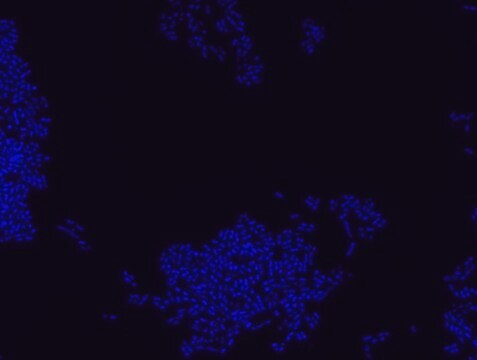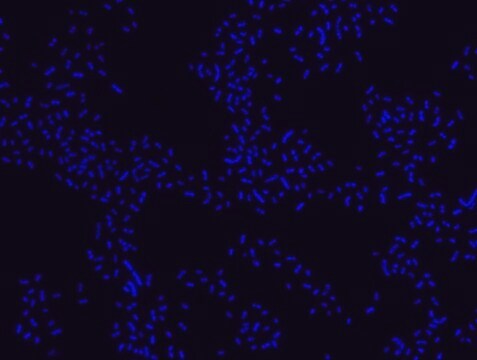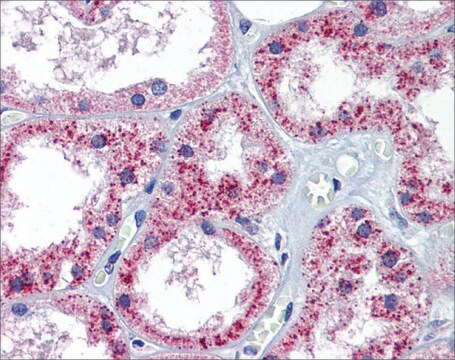MBD0049
Escherichia coli FISH probe -ATTO488
Probe for fluorescence in situ hybridization (FISH), 20µM in water
Autenticatiper visualizzare i prezzi riservati alla tua organizzazione & contrattuali
About This Item
Codice UNSPSC:
12352200
NACRES:
NA.54
Prodotti consigliati
Livello qualitativo
tecniche
FISH: suitable
Fluorescenza
λex 504 nm; λem 521 nm (ATTO488)
Condizioni di spedizione
dry ice
Temperatura di conservazione
−20°C
Descrizione generale
Fluorescent In Situ Hybridization technique (FISH) is based on the hybridization of fluorescent labeled oligonucleotide probe to a specific complementary DNA or RNA sequence in whole and intact cells.1 Microbial FISH allows the visualization, identification and isolation of bacteria due to recognition of ribosomal RNA also in unculturable samples.2
The FISH technique was successfully used to identify E.coli with the probe in various samples such as pure culture (as described in the figure legends and11,13), large and small intestines samples14-16, fecal samples17-21, colonic biopsies18, urine samples, bladder, and kidney sections embedded in paraffin22 and in E.coli biofilm23. It is strongly recommended to include positive and negative controls in FISH assays to ensure specific binding of the probe of interest and appropriate protocol conditions. We offer positive (MBD0032/33) and negative control (MBD0034/35) probes, that accompany the specific probe of interest.
Escherichia coli is a gram negative, facultative aerobic, rod-shaped coliform bacterium. E. coli colonizes the infant gut within hours of birth and establishes itself as the most abundant facultative anaerobe of the human intestinal microflora for the remainder of life, equipped with the abilities to grow in the ever-changing environment in the gut and cope with the mammalian host interaction.8,9 Nevertheless, E. coli can survive in many different ecological habitats, including abiotic environments, and is considered a highly versatile species. Known habitats of E. coli include soil, water, sediment, and food. Some strains of E. coli have evolved and adapted to a pathogenic lifestyle and can cause different disease pathologies.10
Escherichia coli probe specifically recognizes Escherichia coli cells. Yet some reports describe the recognition of other bacteria with this probe, such as, Shigella boydii, Citrobacter davisae, Citrobacter lapagei, Citrobacter neteri11 and Klebsiella pneumoniae12.
The FISH technique was successfully used to identify E.coli with the probe in various samples such as pure culture (as described in the figure legends and11,13), large and small intestines samples14-16, fecal samples17-21, colonic biopsies18, urine samples, bladder, and kidney sections embedded in paraffin22 and in E.coli biofilm23. It is strongly recommended to include positive and negative controls in FISH assays to ensure specific binding of the probe of interest and appropriate protocol conditions. We offer positive (MBD0032/33) and negative control (MBD0034/35) probes, that accompany the specific probe of interest.
Escherichia coli is a gram negative, facultative aerobic, rod-shaped coliform bacterium. E. coli colonizes the infant gut within hours of birth and establishes itself as the most abundant facultative anaerobe of the human intestinal microflora for the remainder of life, equipped with the abilities to grow in the ever-changing environment in the gut and cope with the mammalian host interaction.8,9 Nevertheless, E. coli can survive in many different ecological habitats, including abiotic environments, and is considered a highly versatile species. Known habitats of E. coli include soil, water, sediment, and food. Some strains of E. coli have evolved and adapted to a pathogenic lifestyle and can cause different disease pathologies.10
Escherichia coli probe specifically recognizes Escherichia coli cells. Yet some reports describe the recognition of other bacteria with this probe, such as, Shigella boydii, Citrobacter davisae, Citrobacter lapagei, Citrobacter neteri11 and Klebsiella pneumoniae12.
Applicazioni
Probe for fluorescence in situ hybridization (FISH), recognizes Escherichia coli cells
Caratteristiche e vantaggi
- Visualize, identify and isolate Escherichia coli cells.
- Observe native E. coli cell populations in diverse microbiome environments.
- Specific, sensitive and robust identification of E. coli in bacterial mixed population.
- Specific, sensitive and robust identification even when E. coli is in low abundance in the sample.
- FISH can complete PCR based detection methods by avoiding contaminant bacteria detection.
- Provides information on E. coli morphology and allows to study biofilm architecture.
- Identify E. coli in clinical samples such as, urine samples, bladder and kidney sections (formalin-fixed paraffin-embedded (FFPE) samples), fecal samples and colon tissue.
- The ability to detect E. coli in its natural habitat is an essential tool for studying host-microbiome interaction.
Codice della classe di stoccaggio
12 - Non Combustible Liquids
Classe di pericolosità dell'acqua (WGK)
WGK 1
Punto d’infiammabilità (°F)
Not applicable
Punto d’infiammabilità (°C)
Not applicable
Certificati d'analisi (COA)
Cerca il Certificati d'analisi (COA) digitando il numero di lotto/batch corrispondente. I numeri di lotto o di batch sono stampati sull'etichetta dei prodotti dopo la parola ‘Lotto’ o ‘Batch’.
Possiedi già questo prodotto?
I documenti relativi ai prodotti acquistati recentemente sono disponibili nell’Archivio dei documenti.
B Regnault et al.
Research in microbiology, 151(7), 521-533 (2000-10-19)
There are several occasions when enumeration of Escherichia coli cells is needed. These include examination of urine specimens and water or food samples. Present methods rely on growth in more or less selective media (colony-forming units on agar or the
C Struve et al.
Microbiology (Reading, England), 145 ( Pt 10), 2683-2690 (1999-10-28)
Adhesion mediated by fimbriae is thought to play an important role in the pathogenesis of urinary tract infections (UTI) by Escherichia coli. The majority of clinical isolates of E. coli from UTI are able to express type 1 fimbriae. However
Arthur C Ouwehand et al.
Microbiology and immunology, 48(7), 497-500 (2004-07-24)
The fecal and mucosal microbiota of infants with rectal bleeding and the fecal microbiota of healthy age-matched controls were investigated by fluorescent in situ hybridization. Bifidobacteria were the main genus in both the feces and mucosa. The other genera tested
D Grimm et al.
Applied and environmental microbiology, 64(7), 2686-2690 (1998-07-02)
Based on comparative sequence analysis, we have designed an oligonucleotide probe complementary to a region of 16S rRNA of Legionella pneumophila which allows the differentiation of L. pneumophila from other Legionella species without cultivation. The specificity of the new probe
L K Poulsen et al.
Infection and immunity, 62(11), 5191-5194 (1994-11-01)
Fluorescent oligonucleotide probes targeting rRNA were used to develop an in situ hybridization technique by which the spatial distribution of Escherichia coli in the large intestines of streptomycin-treated mice was determined. Single E. coli cells were identified in thin frozen
Il team dei nostri ricercatori vanta grande esperienza in tutte le aree della ricerca quali Life Science, scienza dei materiali, sintesi chimica, cromatografia, discipline analitiche, ecc..
Contatta l'Assistenza Tecnica.








